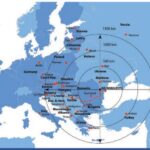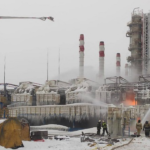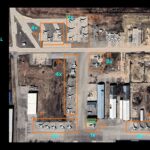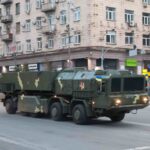The Russian Federation, the Democratic People’s Republic of Korea (DPRK or “North Korea”) and the United States have each conducted major ballistic missile (BM) tests in the span of only a few days between September 30 and October 2, 2019.
RUSSIA: TOPOL-M/ SS-27 “SICKLE B”
The Russian Strategic Missile Forces test-launched a RT-2MP2 Topol-M (NATO reporting name: SS-27 “Sickle B”) intercontinental ballistic missile (ICBM) from a spaceport silo in Plesetsk on November 30, 2019. The ICBM landed 6000 km away in an undisclosed location on the Kamchatka peninsula. According to the Russian Ministry of Defense, the test fire confirmed the technical readiness of the Topol-M ICBM.
#Video A combat-training launch of the #TopolM solid-propellant intercontinental ballistic missile took place today at the Plesetsk cosmodrome, which was to prove the system’s flight and technical performance https://t.co/FoMEHGcjTz #RussianSMF #MissileLaunch #CombatTraining pic.twitter.com/XKVOIobZPO
— Минобороны России (@mod_russia) September 30, 2019
Commissioned in 1997, the Topol-M is a three stage, solid fuel ICBM with a maximum operational range of 10,000 kilometers. Bearing similarity with the American Minuteman III ICBM, the Topol-M has a single, 500 kiloton-yield warhead. As a ground-launch system, the Topol can be fired from both reinforced missile silos and a mobile transporter erector launcher (i.e. MZKT-79221 “Universal” 8×8).

Flight path of Topol-M/ SS-27 “Sickle-B” ICBM during the November, 30 2019 test (T-Intelligence)
Experts believe that the Topol-M has formidable evasive features that significantly increase the missile’s survivability against modern anti-ballistic missile (ABM) systems.
- Short boost phase: Minimizes launch footprint and complicates early-warning threat acquisition.
- Flat ballistic trajectory: Complicates ABM interception.
- Maneuverable and enforced reentry vehicle (RV): Complicates ABM interception in terminal phase due to unpredictable attack path and renders the RV immune to radio, electromagnetic or physical disturbance.
- Countermeasures and decoys: Significant decrease in successful interception, as the vast majority of ABM system are unable to discriminate between targets.
The Kremlin aims to augment its current nuclear ICBM capability through the phased deployment of the RS-24 “Yars” (referred to as the SS-27 Mod. B or SS-29), which contains multiple independently targetable reentry vehicles (MIRVs) as opposed to the single-warhead Topol-M. The RS-24 is believed to be capable of a larger kilotone capacity and extended engagement range.
In addition, Russia is developing a replacement for its obsolete R-36 ICBM, called the RS-28 Sarmat (NATO Reporting name: SS-X-30 Satan II). One “Satan II” ICBM is believed to be able to launch a combination of 10 to 15 MIRVs consisting of conventional nuclear warheads and hypersonic glide vehicles (HGV), including the Avangard.
DPRK: PUKUGUKSONG-3
The Democratic People’s Republic of Korea (DPRK or North Korea) test-fired a previously unidentified submarine launched ballistic missile (SLBM) off Woffsan, on October 1, 2019. The SLBM was identified as the Pukuguksong-3 by the state-controlled media.
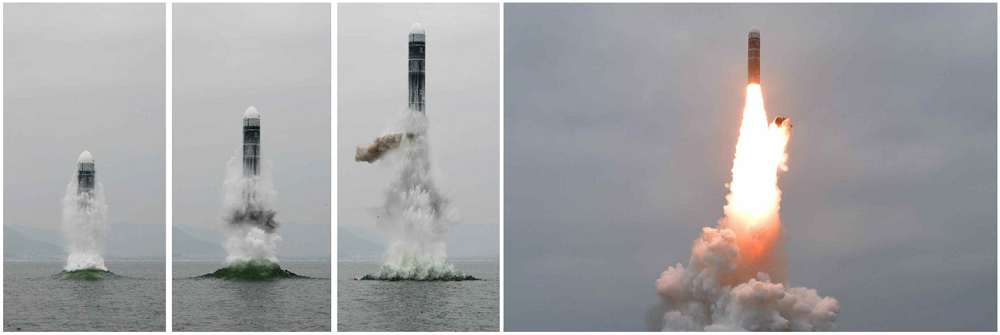
Pukuguksong-3 launched from a submerged platform or submarine courtesy of North Korea state media
According to the Republic of Korea’s (ROK or South Korea) Joint Chiefs of Staff, who constantly monitor DPRK missile tests, the Pukuguksong-3 flew about 450 km on an eastward trajectory and reached an apogee of 910 kilometers. The SLBM landed in Japan’s exclusive economic zone in the East Sea.

Flight path of DPRK’s Pukuguksong-3 SLBM during the October 1, 2019 test (T-Intelligence)
Earlier in July, the DPRK revealed that the Korean People’s Navy (KPN) is developing an another indigenous diesel-powered ballistic missile submarine (SSB) in addition to the existing Sinpo-class SSB (also known as “Gorae”-class) that was deployed in 2014. The new SSB appears to be a modified version of the Russian-made Project 663 submarine (NATO reporting name Romeo-class), with a significantly larger and wider sail to accommodate one solid-fuel Pukuguksong-3 SLBM. The new submarine is expected to enter service in the Sea of Japan soon, according to DPRK-owned media.

Kim Jong-Un inspect DPRK’s newest ballistic missile submarine. In order to conceal technical details, North Korea censored blurred the upper side of the submarine.
Washington has been aware of this new North Korean submarine for more than a year, a senior US official told CNN. Despite the KPN’s recent development of new subsurface capabilities, Seoul assessed that the Pukuguksong-3 was test-fired from a submerged launching platform instead of a submarine. However, the successful testing of the Pukuguksong-3 and the constant advancements in SSB technology show that the DPRK is pursuing a credible (nuclear) second strike capability that is more elusive and difficult to track than land-based systems. While neither of KPN’s nuclear-capable submarines can threaten the US western seaboard, they would represent a force multiplier when it comes to overwhelming ROK, Japanese, and even American (in Guam) ABM defense systems.
US: MINUTEMAN III
The U.S. Air Force Global Strike Command successfully test-fired a Minuteman III ICBM from Vandenberg Air Force Base, California, at 1:13 AM, October 2, 2019. The Minuteman’s RV traveled 6,760 km to the Kwajalein Atoll in the Marshall Islands.
Today the 341st Missile Wing at Malmstrom Air Force Base launched an unarmed Minuteman III Intercontinental ballistic missile equipped with a test reentry vehicle from Vandenberg Air Force Base, California. pic.twitter.com/y3lPmTkSqU
— AFGSC (@AFGlobalStrike) October 2, 2019
Despite the “chain” of missile tests by Russia and the DPRK, the US Air Force (USAF) clarified that the test launch was not in connection to “world events” or “regional tensions.” In fact, the USAF tests its Minuteman III arsenal once or twice every year to ensure that the ICBMs are functional to fulfill their role for nuclear deterrence. The recent test was planned and organized six months to a year in advance.

Flight path of Minuteman III ICBM during the October 2, 2019 test
Ever since the early 1960s, the Minuteman family of missiles has served as the backbone component of US nuclear capability. Starting with 2014, the Minuteman III became the sole American land-based nuclear system. With a maximum range of 13,000 km, the Minuteman III can carry three RV with a combined payload of 350 kiloton. However, under the New START treaty, the US and Russia modified their ICBM arsenal to carry only one warhead per missile.
The 50-years-old Minuteman III will continue to serve as America’s premier land-based nuclear capability until the mid-2030s, when the Ground Based Strategic Deterrent (next-generation ICBM) will be deployed.
Founder of T-Intelligence. OSINT analyst & instructor, with experience in defense intelligence (private sector), armed conflicts, and geopolitical flashpoints.



